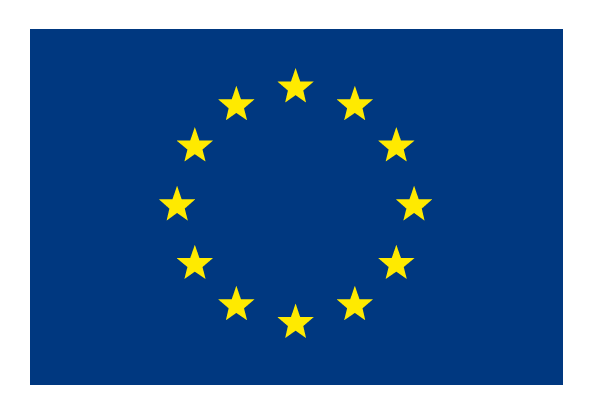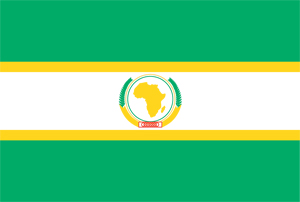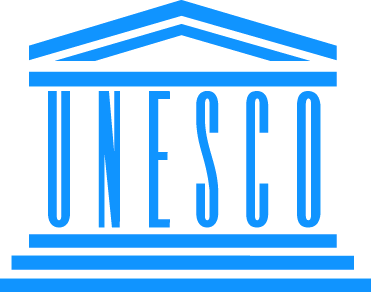First up, we need to have a basic understanding of the evidence that exists which supports the theory of plate tectonics. As simply as it can be put, we have older evidence and newer evidence.
Older Evidence:
- Biology - same fossil formations found in different parts of the world
- Geology - rocks of same afe and type and displaying the same formations found across the globe. Similar glacial deposits are found in Antarctica, South America and India, now many thousands of kilometres apart; striations showing the same orientation when the continents are reunited, are found in Brazil and West Africa.
- Climate - fossils of plants that live in tropical conditions found in Antarctica, with it incredibly unlikely that tropical climatic conditions ever existed in Antarctica's current location. PLaces apart across the globe contain coal deposits of similar age that were formed in tropical conditions; they are no longer in tropical climatic belts therefore must have drifted apart since the Carboniferous period.
New Evidence:
- Discovery of the Mid-Atlantic Ridge (1948)
- Paleomagnetism and the reversal of the Earths magnetic field (1950s)
- Seafloor spreading and then carbon dating of the seafloor rocks (1960s)
 |
| After passing the Curie Point, iron ions within the lava will align to magnetic north...... |
Hopefully, this timeline summarises the key dates and discoveries we need to know about!
Structure of the Earth:
1. Crust :- it is the upper layer which is solid and is divided into 2 types;
- Oceanic crust = mainly basaltic in nature and around 6-10km thick. It is more dense and younger than continental curst
- Continental crust = composed of a wide variety of igneous, metamorphic and sedimentary rock. Can be as much as 70km thick.
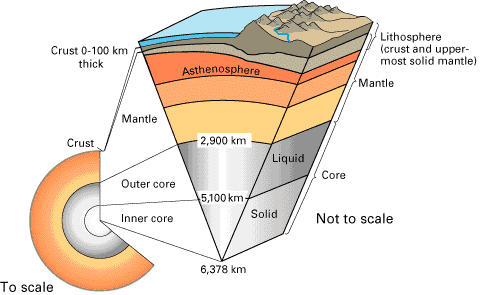
2. Moho Discontinuity :- boundary between the crust and the mantle. Average depth of 8km below oceanic crust and 32 km below continental crust. Has density similar tp an olivine-rich rock such as peridotite and so is less dense than the mantle; as such seismic waves accelerate in this region.
3. Mantle :- below the crust. Upper part is solid and is part of the lithosphere. Below this is the asthenosphere which is partly molten and can flow, whilst the rest of the mantle is liquid.
- Lithosphere = consists of the outer solid part of the Earth, which includse the crust and rigid upper mantle. The lithosphere is about 100km thick, although thickness is age dependent (oldest=thickest). Lithosphere below the crust is brittle enough at some locations to produce earthquakes by faulting, such as within subducted oceanic plate.
- Asthenosphere = ductile part of the Earth just below the lithosphere, including the lower mantle. It is about 180mk thick. Relatively slow seismic movements compared to the lithosphere.
 4. Gutenburg Discontinuity :- boundary between the outer core and the mantle. Where thermal nuclear reactions occur that start convection cells off in the mantle, sending plutons of hot magma upwards. Located at a depth of about 2,800km and marks a sudden increase in density.
4. Gutenburg Discontinuity :- boundary between the outer core and the mantle. Where thermal nuclear reactions occur that start convection cells off in the mantle, sending plutons of hot magma upwards. Located at a depth of about 2,800km and marks a sudden increase in density. 5. Outer Core :- liquid iron-nickel alloy, temperatures of over 6000C.
6. Inner Core : - Solid iron-nickel alloy. Even though temperature is higher than the outer core, the pressure produced by overlying weight is strong enough to prevent the liquid state.
How do we know this? Well, studies of earthquake waves, with regards to the velocities and paths of such waves, depends on what excatly it is they are passing through. P waves can travel through anything but S waves can only pass through solids; so by studying these waves it has been possible for scientists to determine the physical composition of the Earth's interior.
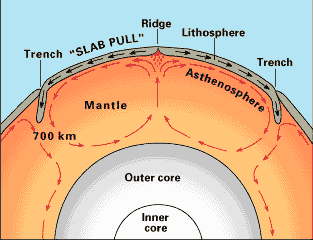
Convection Currents = Driving Force
- Occur in the mantle, very slow convection currents flow in the asthenosphere
- Provide horizontal forces on the plates of the lithosphere, with high temperatures causing updoming and tensional forces pulling the crust apart
- Start in the Gutenburg Discontinuity where thermal nuclear reactions send a pluton upwards
Boundary Types

The Earth's lithosphere is split up into 7 major plates, and around 14 minor ones, with some plates composed of both oceanic and continental crust. Between these plates are boundaries/margins, and there are three main types.......
----- I am going to do a seperate post for each boundary type but, in short:-
- Divergent (constructive) = Plates move away from each other, generating tensional forces. Consequently, characterised by shallow-focus earthquakes and volcanoes producing basaltic magma, forming new oceanic crust. Produces oceanic ridges and rift valleys.
- Convergent (destructive) = Plates move towards one another, generating compressional environments, therefore are characterised by deformation, volcanism, mountain building, seismicity and mineral deposits. Three possible types:-
- Oceanic vs Oceanic
- Oceanic vs Continental
- Continental vs Continental







